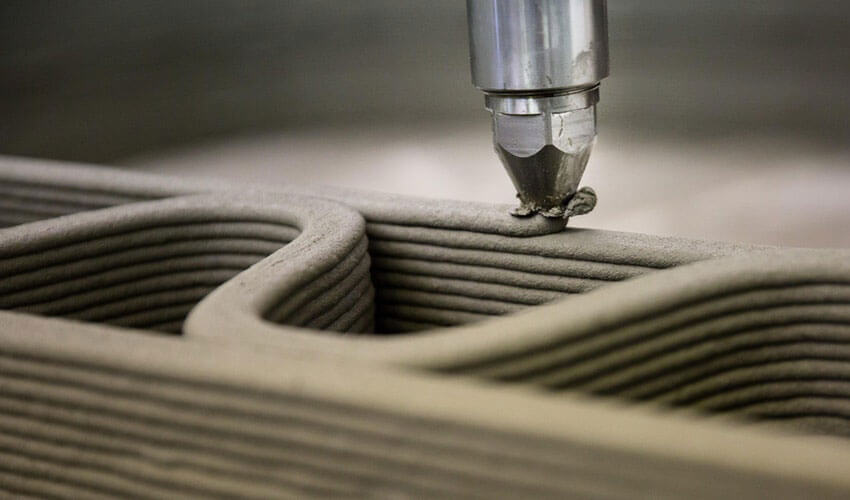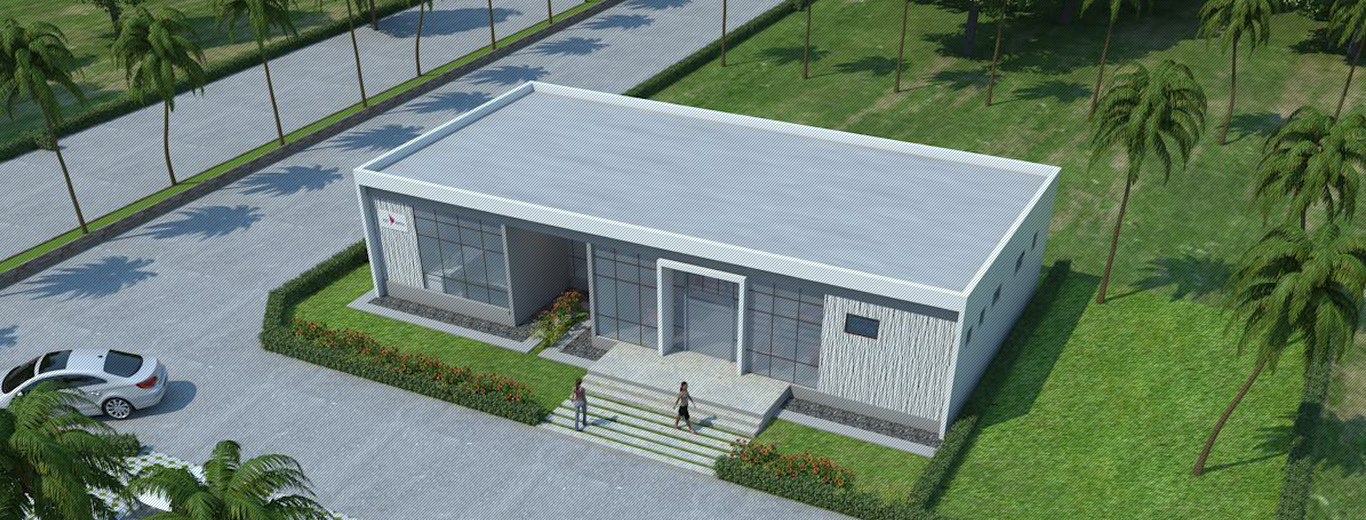3D concrete printing is an innovative and promising technology that can produce complex and customized structures with less material, time, and labor. However, 3D concrete printing also faces many challenges and needs careful selection and control of the material, printer, and process parameters.
3D concrete printing of panels in a factory involves a large-scale gantry system printer that can deposit a special concrete mixture layer by layer to form the panel’s shape and size. The printer is guided by software that has the 3D model of the panel and the exact coordinates for the nozzle movement. The printer can print several panels at once or one after another, depending on the production capacity and demand.

Fig 1: Setup for 3D Printing of Concrete
Courtesy: Hindawi
This article will explain all the factors that affect printing efficiency in detail.
Types of Nozzles for 3D Printing Concrete
The nozzles for touch-ups are usually smaller and more flexible than the main nozzle, and they are used to smooth out the surface of the printed panel, fill in any gaps or cracks, and add any details or decorations. The touch-up nozzles can be mounted on a separate robot arm or gantry or attached to the main nozzle as an auxiliary device. The touch-up nozzles can use the same concrete mixture as the main nozzle or a different one with finer particles or additives.

Fig 2: Nozzle in 3D Printing of Concrete
Courtesy: Sculpteo
Some common types are:
- Circular nozzle: This is the most basic and widely used type of nozzle, which has a circular cross-section and can extrude a uniform line of concrete. The diameter of the nozzle can range from a few millimeters to several centimeters, depending on the desired thickness of the layer.
- Rectangular nozzle: This type has a rectangular cross-section and can extrude a flat concrete ribbon. This can be useful for printing large and flat panels with less material and faster speed.
- Contour nozzle: This type of nozzle has a variable cross-section that can change according to the shape of the panel. This can allow more precise and accurate printing of complex geometries and curves.
- Multi-nozzle: This nozzle has multiple outlets that simultaneously extrude different concrete mixtures or colors. This can enable more creative and diverse designs and patterns on the panel surface.
3D Printing of Concrete Panels with Rhino
3D printing of concrete is done with Rhino by using the software to create a 3D model of the desired shape and size of the concrete structure and then convert it to a mesh file that can be sent to the 3D printer. The concrete mixture must have the right balance of stability and flow to be pumped easily and hold its shape after extrusion. The printing time of 3D concrete printing depends on several factors, such as the size, shape, complexity, and design of the structure, the type and speed of the printer, the flow and curing rate of the concrete mixture, and the environmental conditions.

Fig 3: Rhino Software Drawing Layout in 3D Printing of Concrete
Courtesy: PC Sim
Rhino prepares for 3D printing of concrete by using the following steps:
- Create a 3D model of the desired shape and size of the concrete structure using Rhino’s tools and commands. You can also use plugins like Grasshopper to enable parametric design and create complex or organic shapes.
- Check the 3D model for errors or issues, such as non-manifold edges, naked edges, bad objects, or intersecting surfaces. You can use Rhino’s commands, such as ShowEdges, SelBadObjects, or Intersect, to identify and fix these problems.
- Convert the 3D model to a mesh file that can be sent to the 3D printer. You can use Rhino’s commands, such as Mesh or ReduceMesh, to create a mesh from your model. You can also use plugins like MeshLab or Meshmixer to optimize or edit your mesh.
- Export the mesh file in a format compatible with your 3D printer, such as STL, OBJ, or 3MF. You can use Rhino’s commands, such as Export or SaveAs, to save your mesh file in the desired format.
- Send the mesh file to your 3D printer and start the printing process. The 3D printer will use a large-scale gantry system that can extrude a specially formulated concrete mixture layer by layer to form the structure.
Checklist for 3D Printing of Concrete
A checklist is a useful tool to ensure that the 3D printing of concrete panels is done correctly and efficiently. A checklist can help the operator verify the material’s quality and consistency, the printer’s design and settings, and the process’s performance and safety. Here is an example of a possible checklist for 3D printing concrete panels:
- Material preparation and feeding:
-
-
- Check the quality and quantity of the raw materials, such as cement, sand, water, and additives.
- Check the mixing ratio and consistency of the concrete mixture.
- Check the flowability and pumpability of the concrete mixture.
- Check the curing time and strength development of the concrete mixture.
- Check the availability and functionality of the material feeding system, such as the hopper, pump, hose, and nozzle.
-
- Model design, slicing, and tool path generation:
-
-
- Check the accuracy and feasibility of the 3D model of the panel.
- Check the compatibility and format of the 3D model file with the printer software.
- Check the slicing parameters, such as layer height, width, orientation, and infill pattern.
- Check the tool path generation, such as nozzle speed, position, angle, and pressure.
- Check the printing time and material consumption estimation.
-
- Process parameter design:
-
- Check the environmental conditions, such as temperature, humidity, wind, and sunlight.
- Check the printer calibration and alignment, such as the gantry system, robot arm, or crane.
- Check the printer settings and controls, such as start/stop button, emergency stop button, pause/resume button, speed adjustment knob, etc.
- Check the printer monitoring and feedback system, such as sensors, cameras, or scanners.
- Check the post-processing requirements, such as reinforcement, finishing, or curing.
Productivity in 3D Printing of Concrete Panels
The loss of man-hours in 3D printing of concrete panels may occur due to several factors, such as:
- The preparation and feeding of the concrete mixture which requires careful quality control, mixing ratio, consistency, flowability, pumpability, curing time, and strength development. Any deviation or error in these aspects may affect the printability and performance of the concrete panels.
- The design, slicing, and tool path generation of the 3D model of the panel which requires accuracy and feasibility of the geometry, compatibility, and format of the file, optimal slicing parameters, and tool path generation. Failure or inefficiency in these steps may result in printing defects or failures.
- The process parameter design and execution of the 3D printing process which requires consideration of the environmental conditions, printer calibration and alignment, printer settings, and controls, printer monitoring and feedback system, and post-processing requirements. Any malfunction or misalignment in these aspects may lead to printing errors or quality issues.
The productivity of 3D printing of concrete panels in a factory can be enhanced by:
- Optimizing the mix design, model design, slicing parameters, tool path generation, and process parameters to achieve the best printability and mechanical properties.
- Automating the material preparation and feeding system, the printer calibration and alignment system, the printer monitoring and feedback system, and the post-processing system to reduce human intervention and error.
- Increasing the printing speed, layer height, layer width, nozzle diameter, and nozzle pressure to reduce the printing time and material consumption.
- Improving the quality control and inspection methods to ensure the consistency and reliability of the printed panels.
Enhancing Efficiency in 3D Printing of Concrete Panels: Advanced Techniques and Tools
Some advanced techniques, tools, equipment, or devices that can improve or reduce the time in 3D printing of concrete panels are:
- Nanomaterials and high-performance concrete improve workability, accelerate printing, and increase the binding quality between printed layers. Nanomaterials, such as nano silica, nano clay, or carbon nanotubes, can enhance concrete’s mechanical, thermal, and durability properties by filling the pores and improving the microstructure. High-performance concrete, such as self-compacting or ultra-high-performance concrete, can offer higher strength, ductility, and durability than conventional concrete using special admixtures and fibers. These types of concrete can reduce the printing time by increasing the flowability and pumpability of the mixture and by reducing the curing time and layer thickness.
- Using multiple nozzles or multi-material extrusion enables more creative and diverse designs and patterns on the panel surface. Multiple nozzles can allow for simultaneous or sequential printing of different concrete mixtures or colors, creating more aesthetic and functional effects. Multi-material extrusion can enable the integration of other materials, such as polymers, metals, or ceramics, into the concrete panel, creating more complex and hybrid structures. These techniques can reduce the printing time by eliminating the need for changing or cleaning the nozzle between different materials or colors.
- Contour nozzles or variable cross-section nozzles allow more precise and accurate printing of complex geometries and curves. Contour nozzles can adapt to the panel’s shape by changing the nozzle’s orientation or angle according to the tool path. Variable cross-section nozzles can adjust to the panel size by changing the nozzle’s diameter or shape according to the layer width or height. These nozzles can reduce the printing time by minimizing the material waste and optimizing the layer deposition.
- The use of sensors, cameras, or scanners to monitor and control the printing process in real time and detect and correct any defects or errors. During printing, sensors can measure various parameters, such as temperature, humidity, pressure, flow rate, or displacement, and provide feedback to adjust the printer settings accordingly. Cameras can capture images or videos of the printed panel and analyze them for any cracks, gaps, or deformations using computer vision techniques. With the help of laser scanning or photogrammetry techniques, scanners can scan the printed panel and compare it with the 3D model for any deviations or inaccuracies. These devices can reduce the printing time by ensuring the quality and consistency of the printed panel and avoiding any rework or repair.
Conclusion
In conclusion, 3D concrete panel printing is on the cusp of a remarkable transformation. We’ve explored the pivotal role of cutting-edge techniques, tools, and software, along with the dynamic potential of advanced nozzle technology. These innovations promise to streamline the manufacturing process and hold the key to reduced production times. With the integration of nanomaterials, multi-nozzles, and real-time monitoring, the industry is poised for unprecedented efficiency and creativity. As 3D printing technology continues to evolve, it is clear that the construction landscape is experiencing a paradigm shift, one where precision, speed, and versatility are at the forefront of progress.

